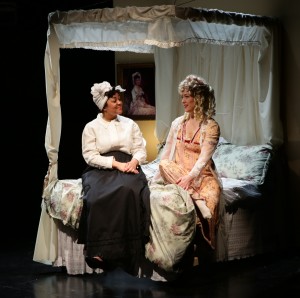Theater Review: “By the Way, Meet Vera Stark” — On Race and Hollywood
The chief glory of the Lyric Stage production is an ensemble of eight actors that agilely accents the humor dramatist Lynn Nottage utilizes to temper her examination of the darker racial and political subtexts of the period.
By The Way, Meet Vera Stark by Lynn Nottage. Directed by Summer L Williams. Staged by the Lyric Stage Company of Boston, Boston, MA, through April 27.
By Iris Fanger

Kami Rushell Smith and Hannah Husband in the Lyric Stage’s production of BY THE WAY, MEET VERA STARK. Photo by Mark S. Howard.
Never mind the gag-lines and the vaudeville-like characters on stage. The real life target of Pulitzer Prize-winning playwright Lynn Nottage’s comic drama By The Way, Meet Vera Stark is not so funny. Nottage had the smart idea to explore the careers and challenges of the African-American actors who appeared as wallpaper—often behind the glamorous, white-skinned stars admired via close-up—in so many black-and-white films of the 1930s–1950s.
She takes as her symbol the actress Vera Stark, who appeared in more than 50 films before dropping out of sight in her later years. Other than Hattie McDaniel, who won an Oscar as best supporting actress for her role in Gone With The Wind, and Bill “Bojangles” Robinson, a popular headliner who danced along side the winsome Shirley Temple in a series of movies, one is hard pressed to recall by name any other black performers from that era of Hollywood, despite their ubiquitous presence.
According to Nottage, the play was sparked when she watched Baby Face, a 1933 film that co-starred Barbara Stanwyck with the African-American actress, Theresa Harris. Although Harris is long forgotten, the film set Nottage to wondering about the Depression and its effects on actors of color. Within a year, the Hays Production Code, a watchdog agency set up to police the subjects, characters, and language chosen for films, narrowed the scope of roles for black actors, reducing them primarily to maids and chauffeurs.
The issue is complicated by the difficulty we have of looking back at a time and place before the national consciousness was raised by the Civil Rights Movement. Racial attitudes have not completely changed by any means, but it is difficult to listen to the cringe-inducing prejudices voiced so thoughtlessly by the white characters in the play. Nottage attempts to cover all the political/cultural angles by breaking the play’s time frame into triplicate: 1933 Hollywood; 1973, when Vera Stark appears on a TV talk show; and 2003, when a group of pretentious academics hold a symposium on Stark’s disappearance, seeing it a metaphor for the neglected black film stars of yesteryear.
The play opens with Vera Stark working as a maid for “America’s Sweetie,” Gloria Mitchell, who is practicing lines for an audition. Mitchell is desperate to win the lead in the upcoming film, The Belle of New Orleans; Stark figures if Mitchell is successful, she can play the character’s slave-servant. Stark and Mitchell are pretty chummy for maid and mistress, a relationship whose complications are revealed at play’s end. Act II opens with eight minutes of film footage, informing the audience that Mitchell and Stark won the parts.
During Act I, we meet Stark’s roommates, Lottie (Lyndsay Allyn Cox) and Anna Mae (Evelyn Howe), wannabe actors like everyone else in Tinsel Town. The producer, Mr. Slavick, comes on with the imperious temper of a Cecil B. DeMille; the self-important, German émigré director, Maxmillian Von Oster, might well be based on Ernst Lubitsch or Fritz Lang. Other than Kami Rushnell Smith as Stark and Hannah Husband as Mitchell, who reappear on the talk show in 1973, the actors change roles for the second act.

Hannah Husband, Kami Rushell Smith, Kelby T. Akin, Gregory Balla in the Lyric Stage production of BY THE WAY, MEET VERA STARK. Photo by Mark S. Howard.
The chief glory of the Lyric Stage production is an ensemble of eight actors that agilely accents the humor Nottage utilizes to temper her examination of the darker racial and political subtexts of the period.
Smith is especially winning as the young Stark, who is armed with talent to spare, her weapons including knowing how to deliver double entendres and to punch up the delivery of her song. Mitchell embodies the insecurity of the cutie, blond starlet, belting gin out of a bottle whenever she needs to stave off fears of her vicious competitors. Terrell Donnell Sledge is affable as Stark’s first husband, a musician who works as a body servant for Slavick; Gregory Balla, who appears first as the snobby, German director, delivers a hilarious cameo as a dumb-head of a rock star who shares the 1973 interview with Stark.
Director Summer L. Williams makes clever use of film clips to vary the pacing and visual texture of the play. A series of atmospheric moving images projected across the back wall (designed by Johnathan Carr) are interspersed throughout the action.
The show’s tensions and diversions are primarily found in watching a group of gifted actors tear into worn showbiz clichés, touching on the desperate truth of the characters’ blocked opportunities in what was then and now Hollywood’s turf of broken dreams.
